RISE Faculty Publication News
In a recent paper published in SMALL 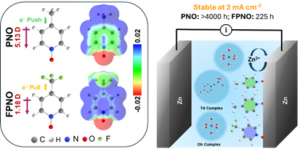 (doi.org/10.1002/smll.202404752) on the ‘Modulation of Electron Push–Pull by Redox Non–Innocent Additives for Long Cycle Life Zinc Anode‘, Arghyadip Manna, Souvik Pal, Bidisa Das*, Satishchandra Ogale*, and Manas K. Bhunia* investigates 4–methyl pyridine N–oxide (PNO) as a redox non–innocent additive that comprises a hydrophilic bipolar N+–O– ion pair as a coordinating ligand for Zn and a hydrophobic –CH3 group at the para position of the pyridine ring that reduces water activity at the EEI, thereby enhancing stability. The N+–O– moiety of PNO possesses the unique functionality of an efficient push electron donor and pull electron acceptor, thus maintaining the desired pH during charging/discharging. The electrolyte with 2M ZnSO4 + 15 mM PNO enables symmetric cell Zn plating/stripping for a remarkable > 10,000 h at 0.5 mA cm–2 and exhibits coulombic efficiency (CE) ~ 99.61% at 0.8 mA cm–2 in Zn/Cu asymmetric cell. This work showcases the immense interplay of the electron push–pull of the additives on the cycling.
(doi.org/10.1002/smll.202404752) on the ‘Modulation of Electron Push–Pull by Redox Non–Innocent Additives for Long Cycle Life Zinc Anode‘, Arghyadip Manna, Souvik Pal, Bidisa Das*, Satishchandra Ogale*, and Manas K. Bhunia* investigates 4–methyl pyridine N–oxide (PNO) as a redox non–innocent additive that comprises a hydrophilic bipolar N+–O– ion pair as a coordinating ligand for Zn and a hydrophobic –CH3 group at the para position of the pyridine ring that reduces water activity at the EEI, thereby enhancing stability. The N+–O– moiety of PNO possesses the unique functionality of an efficient push electron donor and pull electron acceptor, thus maintaining the desired pH during charging/discharging. The electrolyte with 2M ZnSO4 + 15 mM PNO enables symmetric cell Zn plating/stripping for a remarkable > 10,000 h at 0.5 mA cm–2 and exhibits coulombic efficiency (CE) ~ 99.61% at 0.8 mA cm–2 in Zn/Cu asymmetric cell. This work showcases the immense interplay of the electron push–pull of the additives on the cycling.
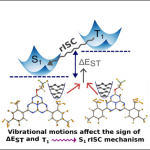 Another recent paper on ‘Reverse Intersystem Crossing Dynamics in Vibronically Modulated Inverted Singlet–Triplet Gap System: A Wigner Phase Space Study’, published in Journal of Physical Chemistry Letters (2024, 15, 30, 7603–7609 ) by Pijush Karak, Pradipta Manna, Ambar Banerjee,* Kenneth Ruud,* Swapan Chakrabarti* inspects the origin of the inverted singlet–triplet gap (INVEST) and slow change in the reverse intersystem crossing (rISC) rate with temperature. INVEST molecules are used in fabrication of OLED, which is expected to the form basis for energy efficient display devices. The author identify the importance of nuclear degrees of freedom for the INVEST phenomenon, and in this case, geometric puckering of the studied molecule determines INVEST and the associated rISC dynamics.
Another recent paper on ‘Reverse Intersystem Crossing Dynamics in Vibronically Modulated Inverted Singlet–Triplet Gap System: A Wigner Phase Space Study’, published in Journal of Physical Chemistry Letters (2024, 15, 30, 7603–7609 ) by Pijush Karak, Pradipta Manna, Ambar Banerjee,* Kenneth Ruud,* Swapan Chakrabarti* inspects the origin of the inverted singlet–triplet gap (INVEST) and slow change in the reverse intersystem crossing (rISC) rate with temperature. INVEST molecules are used in fabrication of OLED, which is expected to the form basis for energy efficient display devices. The author identify the importance of nuclear degrees of freedom for the INVEST phenomenon, and in this case, geometric puckering of the studied molecule determines INVEST and the associated rISC dynamics.
Dr. Arpita Nandy co-authors the editorial article of ‘Sustainability Science and Technology’, launched by IOP Science, titled “IOP journal sustainability science and technology (sus sci tech) in 2024 and beyond: equitable publishing aligned with United Nations’ sustainable development goals (SDGs)”.In this article, the focus areas of the journal are envisioned, and their integration with the SDGs are described. Arpita particularly outlined the scope of biotechnology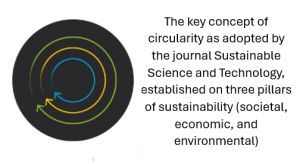 towards attaining sustainability, by highlighting the key areas, such as wastewater management and re-use, biofuels, bioprocesses, carbon capture and storage. The thematic area particularly addresses the issues of Clean Water and Sanitation and Affordable and Clean Energy as part of the sustainable development goals (SDGs). The challenges associated with scalability, cost and reproducibility are also discussed. The authors conclude that successful application of biotechnology in the attainment of SDGs will need to find a harmony between fundamental research and their possible applications and integration with conventional techniques.
towards attaining sustainability, by highlighting the key areas, such as wastewater management and re-use, biofuels, bioprocesses, carbon capture and storage. The thematic area particularly addresses the issues of Clean Water and Sanitation and Affordable and Clean Energy as part of the sustainable development goals (SDGs). The challenges associated with scalability, cost and reproducibility are also discussed. The authors conclude that successful application of biotechnology in the attainment of SDGs will need to find a harmony between fundamental research and their possible applications and integration with conventional techniques.
 In a recent paper published in Catalysis Science and Technology (2024, 14, 8, 2268-2274), titled ‘Investigation of Electrocatalytic Oxygen Evolution Reaction (OER) Selectivity Against Methanol Oxidation on Stainless Steel,’ P. Esakki Karthik*, Luigi Sangaletti, Matteo Ferroni, and Ivano Alessandri examine the potential of stainless steel as an enhanced anode catalyst for electrochemical CO₂ reduction. Their research offers new insights into the use of stainless steel in electrocatalytic reactors, particularly for CO₂ reduction reactions.
In a recent paper published in Catalysis Science and Technology (2024, 14, 8, 2268-2274), titled ‘Investigation of Electrocatalytic Oxygen Evolution Reaction (OER) Selectivity Against Methanol Oxidation on Stainless Steel,’ P. Esakki Karthik*, Luigi Sangaletti, Matteo Ferroni, and Ivano Alessandri examine the potential of stainless steel as an enhanced anode catalyst for electrochemical CO₂ reduction. Their research offers new insights into the use of stainless steel in electrocatalytic reactors, particularly for CO₂ reduction reactions.
Dr. Bidisa Das and her group in the recent computational study ‘Dimerization of Fe(III) Ion in an Aqueous Medium: Mechanistic Modelling and Effects of Ligands‘ published in ChemPhysChem (doi.org/10.1002/cphc.202400144) investigates the mechanistic pathway of dimerization of Fe(III) ions in aqueous 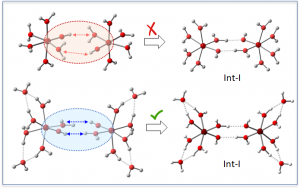 medium considering effects of other ligands using density functional theory (DFT) . Two hydrolyzed monomeric Fe(III) ions in aqueous medium may react to form two closely related binuclear products, the μ‐oxo and the dihydroxo Fe2 dimer. The studies indicate that the water molecules in the second coordination sphere and those co‐ordinated to the Fe(III) ion, both participate in the dimerization process. The proposed mechanism effectively explains the formation of dihydroxo and μ‐oxo Fe2 dimers with interconversion possibilities, for the first time. The calculated results shed light into mechanism of early aggregation of Fe(III) oxyhydroxide minerals found in soils and water bodies.
medium considering effects of other ligands using density functional theory (DFT) . Two hydrolyzed monomeric Fe(III) ions in aqueous medium may react to form two closely related binuclear products, the μ‐oxo and the dihydroxo Fe2 dimer. The studies indicate that the water molecules in the second coordination sphere and those co‐ordinated to the Fe(III) ion, both participate in the dimerization process. The proposed mechanism effectively explains the formation of dihydroxo and μ‐oxo Fe2 dimers with interconversion possibilities, for the first time. The calculated results shed light into mechanism of early aggregation of Fe(III) oxyhydroxide minerals found in soils and water bodies.
A collaborative research on ‘Structural Rearrangement Followed by Entrapment of Subnanometer Building Blocks of Iron Oxyhydroxide in Aqueous Iron Chloride Solutions‘ was published by Dr. Bidisa Das and her group along with Prof. S. Ray (and group) in Inorganic Chemistry (2024, 63, 16, 7255–7265) in which the structural building blocks of Fe(III) oxyhydroxide was experimentally studied. In this experimental study, large quantities of zinc acetate salt (ZA) was added into iron chloride solutions at the olation–oxolation boundary (3.6 mM Fe3+ at pH ∼2.6). Remarkably, this altered the structural arrangement of Fe(III) subnanometer clusters before blocking them in isolation for hours, even at pH 6, where extended iron oxyhydroxide phases typically precipitate. The theoretical study establishes the underlying mechanism by which the growth of larger Fe(III) nanoclusters could be blocked using Zn(II) ion, which adsorbs in few strategic positions.
by Dr. Bidisa Das and her group along with Prof. S. Ray (and group) in Inorganic Chemistry (2024, 63, 16, 7255–7265) in which the structural building blocks of Fe(III) oxyhydroxide was experimentally studied. In this experimental study, large quantities of zinc acetate salt (ZA) was added into iron chloride solutions at the olation–oxolation boundary (3.6 mM Fe3+ at pH ∼2.6). Remarkably, this altered the structural arrangement of Fe(III) subnanometer clusters before blocking them in isolation for hours, even at pH 6, where extended iron oxyhydroxide phases typically precipitate. The theoretical study establishes the underlying mechanism by which the growth of larger Fe(III) nanoclusters could be blocked using Zn(II) ion, which adsorbs in few strategic positions.
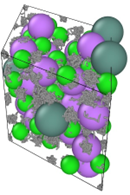
In this paper (which is a part of Indo-Swedish STINT Initiation grant) as published in J. Phys D. Appl. Phys. (57, 145503, 2024) titled “Optimizing solid electrolytes with 3d transition metal doped Li3YCl6 for Li-ion batteries”, Dr. Tanmoy Paul, Dr. Abhik Banerjee and Prof. G. P. Das and Prof. Biplab Sanyal have carried out computational investigations of the effect of doping of 3d transition metals on trigonal Li3YCl6 solid-electrolyte on structure and ionic conductivity. The authors have identified V and Co as candidate dopants in Li3YCl6 which could be possible alternative as solid-electrolyte for all solid state Li-ion batteries. The novelty of the work lies in the correlation of bond ionicity with that of ionic conductivity which has not been shown earlier for this kind of halide solid electrolytes.
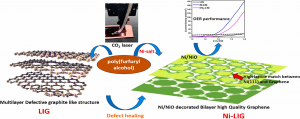 In another recent paper published in Carbon (228, 119275, 2024) on “Nickel catalysed and decorated CO2 laser induced graphene from bio-waste-derived thermoset polymer as a high-performance catalyst for oxygen evolution reaction”, Suparna Saha, Shweta Hiwase, Sukanta Mondal, Ashvini Deshmukh, Satishchandra Ogale investigates the biomass waste derivatives for CO2 laser-assisted graphitization and the role of nickel in the formation of graphite to graphene. The unique advantage of this nickel-catalysed laser pyrolysis is that uniformly graphitization of thermoset polymer that would otherwise yield hard carbons or a mixture of ordered/disordered carbon. During pyrolysis the engraved surface was decorated with a mixture of Ni/NiO that facilitated water dissociation as well as adsorption of water oxidation intermediates. Thus, single-step binder-free Ni/NiO decorated laser induced graphene electrode promotes excellent alkaline OER activity (overpotential 61 mV/dec at 10 mA/cm2 current density). This laser process is not only energetically highly economic vis a vis the conventional furnace processing, but its transient direct-write character also leads to unique materials constitutions that can have interesting property consequences
In another recent paper published in Carbon (228, 119275, 2024) on “Nickel catalysed and decorated CO2 laser induced graphene from bio-waste-derived thermoset polymer as a high-performance catalyst for oxygen evolution reaction”, Suparna Saha, Shweta Hiwase, Sukanta Mondal, Ashvini Deshmukh, Satishchandra Ogale investigates the biomass waste derivatives for CO2 laser-assisted graphitization and the role of nickel in the formation of graphite to graphene. The unique advantage of this nickel-catalysed laser pyrolysis is that uniformly graphitization of thermoset polymer that would otherwise yield hard carbons or a mixture of ordered/disordered carbon. During pyrolysis the engraved surface was decorated with a mixture of Ni/NiO that facilitated water dissociation as well as adsorption of water oxidation intermediates. Thus, single-step binder-free Ni/NiO decorated laser induced graphene electrode promotes excellent alkaline OER activity (overpotential 61 mV/dec at 10 mA/cm2 current density). This laser process is not only energetically highly economic vis a vis the conventional furnace processing, but its transient direct-write character also leads to unique materials constitutions that can have interesting property consequences
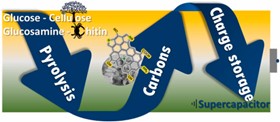
In the research published in the Journal CARBON (214, 118368, 2023) titled “Converting renewable saccharides to heteroatom doped porous carbons as supercapacitor electrodes”, Prof. Satishchandra Ogale, Srinivas Hotha and co-workers have performed a comparative study of heteroatom-based activated saccharide precursors to obtain functional carbons. They showed that activated chitin-derived carbon exhibited high surface area and desired heteroatom functionalities. Acid-base synergistic pre-treatment/activation resulted in an almost 10-fold enhancement in the surface area with multifaceted pore distribution, rendering enhanced charge storage. A dual effect of heteroatom functionalization and activation of saccharide precursors resulted in a high gravimetric capacitance of 172 F/g at 1 A/g in a symmetric two-electrode configuration of chitin polysaccharide samples with a power density of 5000 W/kg at 3.5 W h/kg. It showed capacity retention of up to 100% for over 10,000 cycles.
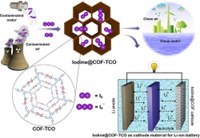 In a paper published in ACS Materials Letters (5, 2422-2430, 2023) titled “Covalent Organic Framework Featuring High Iodine Uptake for Li-Ion Battery: Unlocking the Potential of Hazardous Waste” Dr. Abhik Banerjee, Prof. Satishchandra Ogale and co-workers demonstrated a case study on simultaneous capture of hazardous waste and its concurrent utilization in a sustainable energy application. Thus a new cost-effective and scalable route was designed to synthesize a robust covalent organic framework (COF-TCO) that has been employed for iodine sequestration. The resulting adsorbent selectively captures over 98% of a trace amount of I3– from water with an excellent distribution coefficient (Kd ∼ 104 mL/g), revealing its strong affinity toward iodine. The high uptake capacity of 4.92 g/g was observed in the vapor phase, and efficient performance was achieved over a wide range of water systems, including potable water, lake water, river water, and seawater. Importantly, the iodine-captured COF-TCO was utilized for Li-ion battery applications, and it exhibited a modest specific capacity of 120 mAh/g, when tested against a lithium metal anode.
In a paper published in ACS Materials Letters (5, 2422-2430, 2023) titled “Covalent Organic Framework Featuring High Iodine Uptake for Li-Ion Battery: Unlocking the Potential of Hazardous Waste” Dr. Abhik Banerjee, Prof. Satishchandra Ogale and co-workers demonstrated a case study on simultaneous capture of hazardous waste and its concurrent utilization in a sustainable energy application. Thus a new cost-effective and scalable route was designed to synthesize a robust covalent organic framework (COF-TCO) that has been employed for iodine sequestration. The resulting adsorbent selectively captures over 98% of a trace amount of I3– from water with an excellent distribution coefficient (Kd ∼ 104 mL/g), revealing its strong affinity toward iodine. The high uptake capacity of 4.92 g/g was observed in the vapor phase, and efficient performance was achieved over a wide range of water systems, including potable water, lake water, river water, and seawater. Importantly, the iodine-captured COF-TCO was utilized for Li-ion battery applications, and it exhibited a modest specific capacity of 120 mAh/g, when tested against a lithium metal anode.
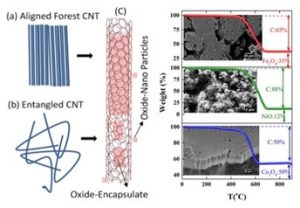 In a recently published paper in J. Phys. D Appl. Phys. 56, 425504, 2023 titled “Synthetically encapsulated & self-organized transition metal oxide nano-structures inside carbon nanotubes as robust: Li-ion battery anode materials” Prof. Satishchandra Ogale, Dr. Ashna Bajpai and co-workers examined the electrochemical performance of four different transition metal oxides encapsulated inside carbon nanotubes (oxides@CNT), along with reference data obtained on a bare-oxide. It was established that the encapsulation leads to superior cyclic stability, irrespective of the type of the oxide-encapsulate. Innovative use of camphor during sample synthesis was shown to enable precise control over the morphology of the filled CNT, which can either be in aligned-forest or in entangled geometry. The morphology appears to play a crucial role in tuning the magnitude of the specific capacity, whereas the encapsulation relates to the cyclic stability.
In a recently published paper in J. Phys. D Appl. Phys. 56, 425504, 2023 titled “Synthetically encapsulated & self-organized transition metal oxide nano-structures inside carbon nanotubes as robust: Li-ion battery anode materials” Prof. Satishchandra Ogale, Dr. Ashna Bajpai and co-workers examined the electrochemical performance of four different transition metal oxides encapsulated inside carbon nanotubes (oxides@CNT), along with reference data obtained on a bare-oxide. It was established that the encapsulation leads to superior cyclic stability, irrespective of the type of the oxide-encapsulate. Innovative use of camphor during sample synthesis was shown to enable precise control over the morphology of the filled CNT, which can either be in aligned-forest or in entangled geometry. The morphology appears to play a crucial role in tuning the magnitude of the specific capacity, whereas the encapsulation relates to the cyclic stability.
 In a recent study reported in the journal SMALL (2300792, 2023) titled “Design and Piezoelectric Energy Harvesting Properties of a Ferroelectric Cyclophosphazene Salt” Prof. Satishchandra Ogale, Prof. R. Boomishankar and co-workers reported for the first time the synthesis and energy application of an organophosphazene-based supramolecular ferroelectric [(PhCH2NH)6P3N3Me]I, [PMe]I which crystallizes in the polar space group Pc, with its thin-film sample exhibiting remnant polarization of 5 μC cm−2. Flexible composites of [PMe]I were fabricated for piezoelectric energy harvesting applications using thermoplastic polyurethane (TPU) as the matrix. The highest open-circuit voltages of 13.7 V and the maximum power density of 34.60 μW cm−2 were recorded for the poled 20 wt.% [PMe]I/TPU device.
In a recent study reported in the journal SMALL (2300792, 2023) titled “Design and Piezoelectric Energy Harvesting Properties of a Ferroelectric Cyclophosphazene Salt” Prof. Satishchandra Ogale, Prof. R. Boomishankar and co-workers reported for the first time the synthesis and energy application of an organophosphazene-based supramolecular ferroelectric [(PhCH2NH)6P3N3Me]I, [PMe]I which crystallizes in the polar space group Pc, with its thin-film sample exhibiting remnant polarization of 5 μC cm−2. Flexible composites of [PMe]I were fabricated for piezoelectric energy harvesting applications using thermoplastic polyurethane (TPU) as the matrix. The highest open-circuit voltages of 13.7 V and the maximum power density of 34.60 μW cm−2 were recorded for the poled 20 wt.% [PMe]I/TPU device.
 In a recent paper published in ACS Appl. Mater. Interfaces (15, 23093-23103, 2023) titled “Mitigating Dendrite Formation on a Zn Electrode in Aqueous Zinc Chloride by the Competitive Surface Chemistry of an Imidazole Additive” Mr. Ashutosh Rana, Dr. Bidisa Das, Prof. Satishchandra Ogale and Dr. Abhik Banerjee examined the role of imidazole as an electrolyte additive in 2 M ZnCl2 to prevent dendrite formation during zinc electrodeposition via experimental (kinetics and imaging) and theoretical density functional theory (DFT) studies. Towards this end, linear sweep voltammetry (LSV) and chronoamperometry (CA) were performed with in situ monitoring of the electrodeposited zinc. The addition of 0.025 wt % imidazole to 2 M ZnCl2 increases the cycle life of Zn-symmetric cells cycled at 1 mA/cm2 for 60 min of plating and stripping dramatically from 90 to 240 h. A higher value of the nucleation overpotential is noted in the presence of imidazole, which suggests that imidazole is adsorbed at a competitively faster rate on the surface of zinc, thereby suppressing the zinc electrodeposition kinetics and the formation. It was observed that the electrodeposition of zinc is more homogeneous in the presence of imidazole, and its presence in the electrolyte also inhibits the production of a passivating coating (ZnO) on the Zn surface, thereby preventing corrosion.
In a recent paper published in ACS Appl. Mater. Interfaces (15, 23093-23103, 2023) titled “Mitigating Dendrite Formation on a Zn Electrode in Aqueous Zinc Chloride by the Competitive Surface Chemistry of an Imidazole Additive” Mr. Ashutosh Rana, Dr. Bidisa Das, Prof. Satishchandra Ogale and Dr. Abhik Banerjee examined the role of imidazole as an electrolyte additive in 2 M ZnCl2 to prevent dendrite formation during zinc electrodeposition via experimental (kinetics and imaging) and theoretical density functional theory (DFT) studies. Towards this end, linear sweep voltammetry (LSV) and chronoamperometry (CA) were performed with in situ monitoring of the electrodeposited zinc. The addition of 0.025 wt % imidazole to 2 M ZnCl2 increases the cycle life of Zn-symmetric cells cycled at 1 mA/cm2 for 60 min of plating and stripping dramatically from 90 to 240 h. A higher value of the nucleation overpotential is noted in the presence of imidazole, which suggests that imidazole is adsorbed at a competitively faster rate on the surface of zinc, thereby suppressing the zinc electrodeposition kinetics and the formation. It was observed that the electrodeposition of zinc is more homogeneous in the presence of imidazole, and its presence in the electrolyte also inhibits the production of a passivating coating (ZnO) on the Zn surface, thereby preventing corrosion.
 Resistive switching is considered a highly desirable energy saving memory storage scheme for the emergent data science and rapidly developing extensive computational framework. In a recent study reported in ACS Applied Electronic Materials (5, 1536-1545, 2023) titled “Resistive Switching in CsPbBr3 (0D)/MoS2 (2D) Heterojunction System: Trap-Controlled Space Charge Limited Transport Mechanism” Prof. Satishchandra Ogale, Dr. Tajashree Bhave and co-workers examined a 0D/2D interface system involving two materials of great current interest, namely, a halide perovskite CsPbBr3 (CPB QDs) (0D) and a 2D chalcogenide MoS2; their choice based on their favourable band alignment for the targeted application. Simple solution-based synthetic protocols rendered electronically active interface exhibiting an impressive and robust resistive switching characteristic with the ratio of resistances in high resistance state (HRS) and low resistance state (LRS) of ∼12 retained over 100 cycles for which tests were conducted without decay. The memristor functionality was shown to emanate from the trap-controlled space charge limited conduction (SCLC) mechanism.
Resistive switching is considered a highly desirable energy saving memory storage scheme for the emergent data science and rapidly developing extensive computational framework. In a recent study reported in ACS Applied Electronic Materials (5, 1536-1545, 2023) titled “Resistive Switching in CsPbBr3 (0D)/MoS2 (2D) Heterojunction System: Trap-Controlled Space Charge Limited Transport Mechanism” Prof. Satishchandra Ogale, Dr. Tajashree Bhave and co-workers examined a 0D/2D interface system involving two materials of great current interest, namely, a halide perovskite CsPbBr3 (CPB QDs) (0D) and a 2D chalcogenide MoS2; their choice based on their favourable band alignment for the targeted application. Simple solution-based synthetic protocols rendered electronically active interface exhibiting an impressive and robust resistive switching characteristic with the ratio of resistances in high resistance state (HRS) and low resistance state (LRS) of ∼12 retained over 100 cycles for which tests were conducted without decay. The memristor functionality was shown to emanate from the trap-controlled space charge limited conduction (SCLC) mechanism.
 In a recent publication in J. Mater. Chem. A (11, 8972-8987, 2023) titled “Superior oxygen evolution reaction performance of NiCoFe spinel oxide nanowires in situ grown on β-Ni(OH)2 nanosheet-decorated Ni foam: case studies on stoichiometric and off-stoichiometric oxides” Prof. Satishchandra Ogale, Dr. Seema Verma and co-workers studied stoichiometric [NiCo(2−x)FexO4 (x=0.125, 0.25)] and Co-excess off-stoichiometric [Ni0.75Co(2.25−x)FexO4] NiCoFe spinel oxide nanostructures self-grown on a β-Ni(OH)2 nanosheet-decorated Ni foam (NF) substrate for their oxygen evolution reaction (OER) performance. As the hierarchical porous nanowire architecture is binder-free, these hetero-structural nanocomposite materials have great potential for enhanced mass-transport, improved conductivity and excellent electrochemical stability even at a current density as high as 250 mA cm−2. The synergistic effects originating from structural and compositional advantages empowered NiCo1.75Fe0.25O4@NiO@NF nanocomposites to show superior OER performance owing to the higher proportion of Ni3+/Ni2+ and Co2+/Co3+ ions on active octahedral sites and enhanced ferromagnetic double exchange interactions primarily triggered by oxygen vacancies. The nanocomposites showed exceptionally high electrocatalytic activity with an ultralow overpotential value of 272 (±5) mV at 100 mA cm−2 and a small Tafel slope of 54 mV dec−1. A high conservation rate of catalytic activity (99%) for hetero-structural nanocomposites was noted even after 24 h of continuous electrolysis at 50 mA cm−2.
In a recent publication in J. Mater. Chem. A (11, 8972-8987, 2023) titled “Superior oxygen evolution reaction performance of NiCoFe spinel oxide nanowires in situ grown on β-Ni(OH)2 nanosheet-decorated Ni foam: case studies on stoichiometric and off-stoichiometric oxides” Prof. Satishchandra Ogale, Dr. Seema Verma and co-workers studied stoichiometric [NiCo(2−x)FexO4 (x=0.125, 0.25)] and Co-excess off-stoichiometric [Ni0.75Co(2.25−x)FexO4] NiCoFe spinel oxide nanostructures self-grown on a β-Ni(OH)2 nanosheet-decorated Ni foam (NF) substrate for their oxygen evolution reaction (OER) performance. As the hierarchical porous nanowire architecture is binder-free, these hetero-structural nanocomposite materials have great potential for enhanced mass-transport, improved conductivity and excellent electrochemical stability even at a current density as high as 250 mA cm−2. The synergistic effects originating from structural and compositional advantages empowered NiCo1.75Fe0.25O4@NiO@NF nanocomposites to show superior OER performance owing to the higher proportion of Ni3+/Ni2+ and Co2+/Co3+ ions on active octahedral sites and enhanced ferromagnetic double exchange interactions primarily triggered by oxygen vacancies. The nanocomposites showed exceptionally high electrocatalytic activity with an ultralow overpotential value of 272 (±5) mV at 100 mA cm−2 and a small Tafel slope of 54 mV dec−1. A high conservation rate of catalytic activity (99%) for hetero-structural nanocomposites was noted even after 24 h of continuous electrolysis at 50 mA cm−2.
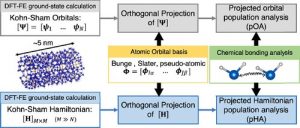 In a recent paper published in J. Chem. Theory Comput. (19, 4216 2023) titled “Chemical Bonding in Large Systems Using Projected Population Analysis from Real-Space Density Functional Theory Calculations”, Prof. Gour P. Das, along with with P. Motamarri (IISc), S. Bhattacharjee (IKST) and their groups have proposed an efficient and scalable computational approach for conducting projected population analysis from real-space finite-element (FE)-based Kohn–Sham density functional theory calculations (DFT-FE). This work provides an important direction toward extracting chemical bonding information from large-scale DFT calculations on materials systems involving thousands of atoms while accommodating periodic, semi-periodic, or fully nonperiodic boundary conditions. They have demonstrated this new methodology to extract the quantitative chemical bonding information of hydrogen chemisorbed in large silicon nanoparticles alloyed with carbon, which is a candidate material for hydrogen storage.
In a recent paper published in J. Chem. Theory Comput. (19, 4216 2023) titled “Chemical Bonding in Large Systems Using Projected Population Analysis from Real-Space Density Functional Theory Calculations”, Prof. Gour P. Das, along with with P. Motamarri (IISc), S. Bhattacharjee (IKST) and their groups have proposed an efficient and scalable computational approach for conducting projected population analysis from real-space finite-element (FE)-based Kohn–Sham density functional theory calculations (DFT-FE). This work provides an important direction toward extracting chemical bonding information from large-scale DFT calculations on materials systems involving thousands of atoms while accommodating periodic, semi-periodic, or fully nonperiodic boundary conditions. They have demonstrated this new methodology to extract the quantitative chemical bonding information of hydrogen chemisorbed in large silicon nanoparticles alloyed with carbon, which is a candidate material for hydrogen storage.
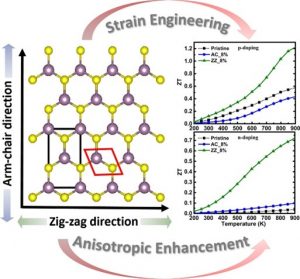 In this paper (which is part of the PhD work of Saumen Choudhuri) published in Appl. Surf. Sci. (626, 157139 2023) titled “Strain driven anomalous anisotropic enhancement in the thermoelectric performance of monolayer MoS2”, Professors Gour P. Das, B.N. Dev (CQuERE), A. Bhattacharya (IIT Bom) and coworkers investigated the strain and temperature induced tunability of the thermoelectric properties of monolayer (ML) MoS2. Modifications in the electronic and phononic transport properties, under two anisotropic uniaxial strains along the armchair (AC) and zigzag (ZZ) directions, have been explored in detail. The large reduction in thermal conductivity and remarkable increase in relaxation time, associated with the strains along the ZZ direction, act in unison to result in enhanced efficiency and hence improved thermoelectric performance. Nearly 150% enhancement in the thermoelectric efficiency can be achieved with the optimal doping concentration. The significance of in-plane tensile strains, in general, and strains along the ZZ direction, were highlighted in particular, in improving the thermoelectric performance of ML-MoS2.
In this paper (which is part of the PhD work of Saumen Choudhuri) published in Appl. Surf. Sci. (626, 157139 2023) titled “Strain driven anomalous anisotropic enhancement in the thermoelectric performance of monolayer MoS2”, Professors Gour P. Das, B.N. Dev (CQuERE), A. Bhattacharya (IIT Bom) and coworkers investigated the strain and temperature induced tunability of the thermoelectric properties of monolayer (ML) MoS2. Modifications in the electronic and phononic transport properties, under two anisotropic uniaxial strains along the armchair (AC) and zigzag (ZZ) directions, have been explored in detail. The large reduction in thermal conductivity and remarkable increase in relaxation time, associated with the strains along the ZZ direction, act in unison to result in enhanced efficiency and hence improved thermoelectric performance. Nearly 150% enhancement in the thermoelectric efficiency can be achieved with the optimal doping concentration. The significance of in-plane tensile strains, in general, and strains along the ZZ direction, were highlighted in particular, in improving the thermoelectric performance of ML-MoS2.
 In this paper (which is part of the PhD work of Saumen Choudhuri) published in Physica B: Conden. Matter (655, 414701 2023) titled “Strain induced effects on the electronic and phononic properties of 2H and 1T′ monolayer MoS2 “, Professors Gour P. Das and B.N. Dev (CQuERE) addressed the strain-induced tunability of the electronic and the phononic properties of both 2H and 1T′ phases of monolayer MoS2 , and compared their stability. For the 2H phase, a direct to indirect band gap transition, followed by the band gap lowering leading to a semiconductor to metal transition, was observed. The applied strain destroys the semimetallic nature of the 1T′ phase. The 2H phase appears to withstand a larger amount of strain indicating better stability compared to the 1T′ phase. They also highlighted the significance of anisotropic strain-engineering in tuning the electronic and phononic properties and the stability limit of monolayer 1T′-MoS2.
In this paper (which is part of the PhD work of Saumen Choudhuri) published in Physica B: Conden. Matter (655, 414701 2023) titled “Strain induced effects on the electronic and phononic properties of 2H and 1T′ monolayer MoS2 “, Professors Gour P. Das and B.N. Dev (CQuERE) addressed the strain-induced tunability of the electronic and the phononic properties of both 2H and 1T′ phases of monolayer MoS2 , and compared their stability. For the 2H phase, a direct to indirect band gap transition, followed by the band gap lowering leading to a semiconductor to metal transition, was observed. The applied strain destroys the semimetallic nature of the 1T′ phase. The 2H phase appears to withstand a larger amount of strain indicating better stability compared to the 1T′ phase. They also highlighted the significance of anisotropic strain-engineering in tuning the electronic and phononic properties and the stability limit of monolayer 1T′-MoS2.
 In this paper (which is part of the PhD work of Saumen Choudhuri) published in J. Electronic Materials (52, 1633 2023) titled “Ab Initio Study of Electronic and Lattice Dynamical Properties of Monolayer ZnO Under Strain”, Professors Gour P. Das and B.N. Dev (CQuERE), carried out first principles DFT investigation for the strain-induced modifications in the electronic and vibrational properties of monolayer (ML)-ZnO. A wide range of in-plane bi-axial tensile and compressive strain along different directions were applied to analyse the modifications in the band gap, frequencies of the in-plane and out-of-plane acoustic modes showing linear dispersion, and most importantly the out-of-plane flexural (ZA) mode showing quadratic dispersion. Furthermore, the potential of ML-ZnO to be a good thermoelectric material is analysed in an intuitive way based on the calculated electronic and phononic properties. Our results, thus, not only highlight the significance of strain-engineering in tailoring the electronic and vibrational properties but also provide a thorough understanding of the lattice dynamics and mechanical strength of ML-ZnO.
In this paper (which is part of the PhD work of Saumen Choudhuri) published in J. Electronic Materials (52, 1633 2023) titled “Ab Initio Study of Electronic and Lattice Dynamical Properties of Monolayer ZnO Under Strain”, Professors Gour P. Das and B.N. Dev (CQuERE), carried out first principles DFT investigation for the strain-induced modifications in the electronic and vibrational properties of monolayer (ML)-ZnO. A wide range of in-plane bi-axial tensile and compressive strain along different directions were applied to analyse the modifications in the band gap, frequencies of the in-plane and out-of-plane acoustic modes showing linear dispersion, and most importantly the out-of-plane flexural (ZA) mode showing quadratic dispersion. Furthermore, the potential of ML-ZnO to be a good thermoelectric material is analysed in an intuitive way based on the calculated electronic and phononic properties. Our results, thus, not only highlight the significance of strain-engineering in tailoring the electronic and vibrational properties but also provide a thorough understanding of the lattice dynamics and mechanical strength of ML-ZnO.